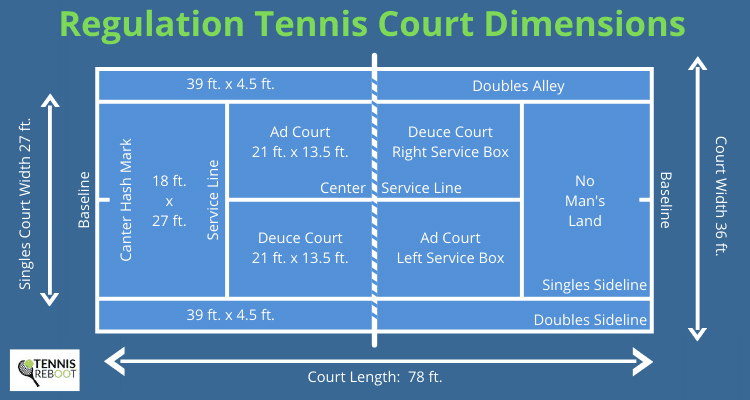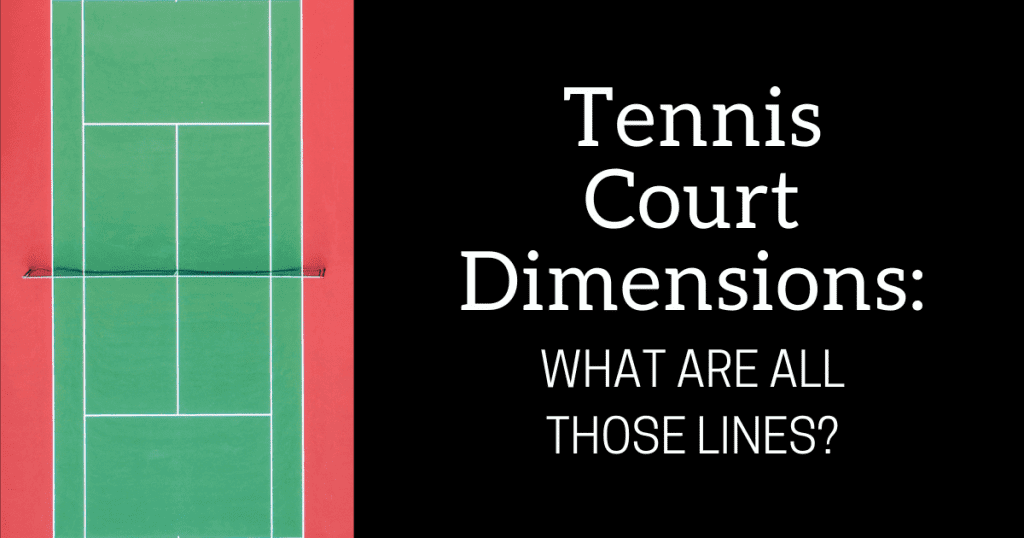Playing tennis can be intimidating – especially for new players. The dimensions and layout of the court are different from other sports such as basketball or football.
There are a number of lines and a net smack dab in the middle of the court.
Let’s get into the details… what are the dimensions of a tennis court?
Contents
How Much Space Does a Tennis Court Take Up?
You may wonder how big is a tennis court or how many square feet is a tennis court?
A tennis court is 78 feet long by 36 feet wide. With those measurements, the square footage is 2,808 feet – for the entirety of the court.
When playing singles, you’re only using part of that square footage.
The singles lines are 78 feet long by 27 wide which equates to 2,106 square feet.
As a picture is worth a thousand words, here’s a tennis court diagram with the many areas identified.

Tennis Court Dimensions & Measurements
In case the diagram isn’t clear to you, here’s a breakdown of the lines present on a tennis court.
Length and Width of a Tennis Court
From baseline to baseline, the length of a tennis court is 78 feet.
The width of a tennis court (from doubles line to doubles line) 36 feet.
The width of a tennis court (from singles line to singles line) 27 feet.
Tennis Court Areas
Doubles Alley: 39 feet x 4.5 feet
Services Boxes: Length of Service Box: 21 feet (from net to back of service line) Width of Service Box: 13.5 feet (from singles sideline to center service line)
No Man’s Land: 18 feet x 27 feet
Net: 3 feet high in the center, 3.5 feet high at the net posts
Doubles Alleys
There are two sets of doubles alleys, one on each side of the court. This area of the court is used during doubles play.
Service Boxes
The service boxes are a section of a tennis court. They are made up by four boundaries: the net, the center service line, and the (back) service line, and the singles sideline.
Whether playing singles or doubles, the service box remains the same with the service line not extending beyond the singles sideline.
No Man’s Land
The dreaded No Man’s Land area… It’s the space on the court between the baseline and the service line.
If you find yourself there, you won’t be in the best position to hit much successfully which is why it’s called “No Man’s Land.”
You can’t truly volley as you’re not close enough to the net and it’s harder to hit groundstrokes.
Tennis Court Net Height
Tennis nets are supposed to measure 3 feet high in the center and 3.5 feet high at the net posts. The net gets gradually higher as you move from the center of the court to the sidelines.
Tennis Court Lines
Baseline
The baseline represents the furthest boundary from the net on a tennis court. It’s the originating point for most groundstrokes to be hit and generally where you stand to return serves.
If a ball goes beyond the baseline during any point, it is out.
Center “Hash” Mark
A small, 4-inch line, but one that divides the court into 2 halves just like the center service line does.
Serves must originate on either side of the center hash mark. If you cross the line before making contact with your serve, it will be a fault.
Center Service Line
The center service line separates the court into two halves lengthwise. It runs perpendicular to the net.
Singles Sidelines
Like the center service line and the doubles sideline, the singles sidelines run perpendicular to the net.
They’re aptly named as they create the side boundaries of the court for singles play.
Within each singles sideline, from the net to the baseline, is consider the singles court.
Doubles Sidelines
Like the center service line and the singles sideline, the doubles sidelines run perpendicular to the net.
They create the side boundaries of the court for doubles play.
The singles sideline and doubles sideline make up the doubles alley. Within the doubles sidelines, from the net to the baseline, is considered the doubles court.
FAQs

How Wide Are the Lines On a Tennis Court?
Other than the baseline, tennis court lines should be 2 inches wide. The baseline can be up to 4 inches wide.
What is the Total Area of a Tennis Court?
The total area of a tennis court, according to the International Tennis Federation rulebook, is defined as 78 feet by 36 ft or 2,808 square feet.
The longest side runs from baseline to baseline and the shortest sides run perpendicular to the baselines.
What is the Best Surface for a Tennis Court?
The best surface for a tennis court depends on what type of player you are and personal preference.
In general, clay is considered to be the preferred surface for many simply because the court grips and slows the ball down more than other surfaces do.
Clay is also a cooler surface to play on so that’s often more enjoyable.
The Long and Short of Tennis Court Dimensions
Whether playing at your local tennis center or watching a match at Wimbledon, tennis court dimensions are highly regulated.
Clay court, grass court, hard court, indoor court, carpet court – no matter the court surface, the lines are all the same. You may see a court where there are no doubles alleys, but the playing area and measurements remain the same.
While playing tennis on your home court may feel like an advantage, the court size is the same no matter where you play.
If any of these terms are unfamiliar, check out our rundown of tennis terminology so you’re familiar with all the tennis lingo!
